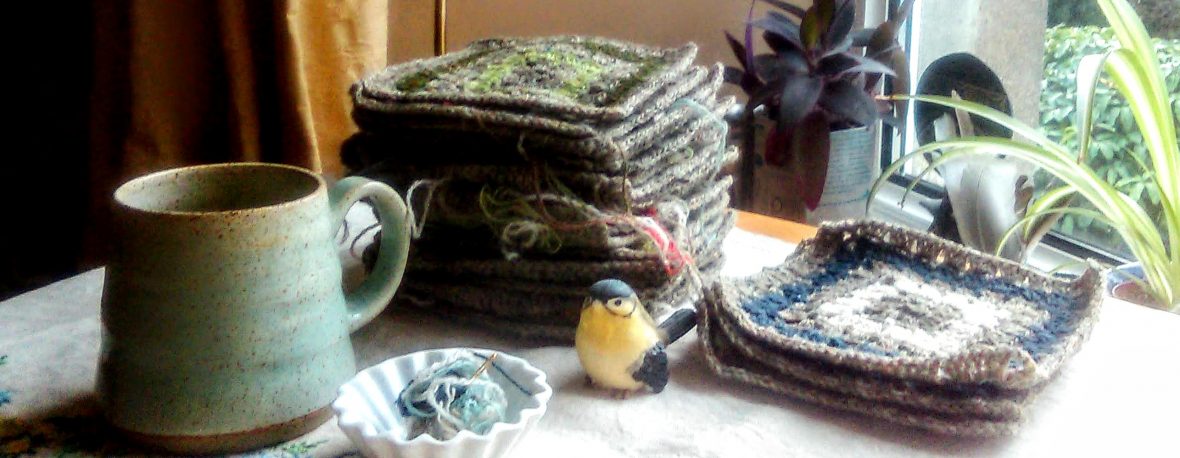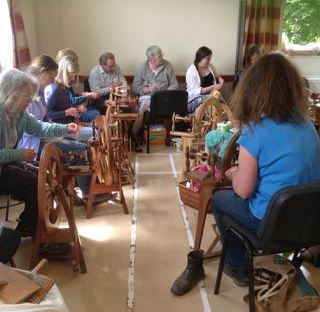Every year the wool company Wingham Wool comes to visit my local Guild. it is always very exiting, as it is a bit like wine tasting! It is trial spinning of all the fibres on offer! I was very positively surprised to find a good range of British Sheep Roving and again discovered breeds I hadn’t heard before like Massham sheep.I bought some Wensleydale fleece, which still needs carding and some Black Welsh. there is so much more to learn for me and I find this endlessly fascinating!
Tag: Hand spinning
Ancient Tools, Wool and Time at Archie Browns, Truro
Jamie Mills, who works at Archie Browns, a Health Food Shop, Vegetarian Cafe and Deli, asked me a while ago to show some of my recent work in the cafe.
With gratitude I accepted the kind offer and since July a show of photos and and a small installation (hand spun, plant dyed and hand knitted).
The photos are documentation of wool processes, from a visit at the Natural Fibre Company, Launceston, Bosigran Farm in Penwith, and my own processes of spinning and dying.
The exhibition is s glimpse into my art practise, where I am exploring wool as a sustainable material, natural and local resources and slow processes as a reflection and invitation to wellbeing.
The fibre, I used, came from the Natural Fibre Mills and is their carding waste.
Occasionally during in the carding processes something goes wrong, or there is a overlap between two carding lots, say Shetland and Wensleydale, (one could say its a mongrel) and the fibre can not be used for further processes.The shawl also does demonstrate my first adventure into dying with natural plant dyes, in this case onion skins, weld (yellow) and woad (blue).
Artist Statement
Wool is a living material, its connotations of clothing and keeping human mankind warm goes back to the beginning of humanity.
Wool provides the link, between our history and our presence, which I feel in my hands while engaging with a raw fleece, while quietly sitting watching how my hand spindle turns a cloud of something unformed into a form, a yarn.
The yarn becomes a symbol, it is the umbilical cord to the land, which feeds and clothes us.
The pieces, I created from this yarn become the witnesses of the time spend and an embodied holder the memory of this time: they invite reflection about our choices how we pass our time.
Wool becomes my companion in my daily enjoyment and engagement, the slow movement of a spindle, of a wooden needle grounds me, slows down time and lets my breath become slow and deep, guides me back into the presence. Wool speaks to people, brings back memories, asks to be touched, to be held and invites to use their hands and cherish the fruits of their hands, again.
Wool asks for tools and company, in such it becomes the vehicle to initiate collaborations with other artist, craftspeople and sometimes musicians.
Wool is my tool and aide to heal my own connection to the land and through my work and my invitations to others to share my vision and hope: fostering reflections towards a healed relationships with our environment, the one and only world we are living in.
Making skeins
Making Skeins
i spend the morning spinning with this almost white fleece, I don’t know what breed it is as it comes from the carding waste. It has a beautiful lustre when it comes of the cob ( the cob is the wool which comes of the spindle). It was very still and quiete in the studio, the 1. Years are going through their induction phase.
Later on I wound the yarn from the cob into skeins with the help do a niddy noddy. When I mentioned to my partner first that I needed to use a niddy noddy, he thought I was joking and making it up.
Mine came from Carol Grace, retired Textile lecturer and it is a very useful tool to wind yarn into skeins when no helping “arms” are around.
The skeins are the next step of preparation for dying the yarn.
The Guild of Weavers, Spinners and Dyers Cornwall is holding coming Friday an Indigo Dying day and I will attend.
It is quite humbling for me to see the fruits of my labor, by Friday , I will have 5 skein of whitish yarn. I didn’t clock the time, because being with the spinning, the process, the hand movements, which slowly but surely becoming more familiar is what holds my fascination. The feel and the texture of the fleece and the still lingering smell of sheep bring the origin of my material back to me. The memory of an afternoon spend on Bosigran farm, even though we had missed the sheering, the sheep and billy goats were still about.
Working with very little processed wool feels like going back to a source material, something basic and still so essential ……
How does one give a reflective commentary about a meditative and grounding experience? It has to be experience, to be embodied , become part of life………………
The studio is deserted, students gone home, it is still, I can hear the traffic, the late afternoon light begins to fade, I long to be outside with my spindle……..
Spinning in the Grease

Friday , 10. Oct. 2014
it is quite here on a Friday afternoon, people go home early.
I get lost in the process of spinning.
The rhythmic movements, repeating, spin, draw, wind unto the spindle, spin……. The fleece feels sticky, after a while there is on my finger brown grease residue. The yarn feels rough, I am pleased about a reasonable consistency in the thickness . I realise, I hardly notice the smell anymore.
Another small bucket full of fleece is washed and will dry over the week-end.
alongside I am listening to some Scandinavian or far more correct Sami music, Joiks, songs often with out words.
Spinning and listing to ancient music evokes a strong sense of appreciation in me. We are linked with our ancestors and in rediscovering these old links we can strengthening our sense of belonging to this earth.

































